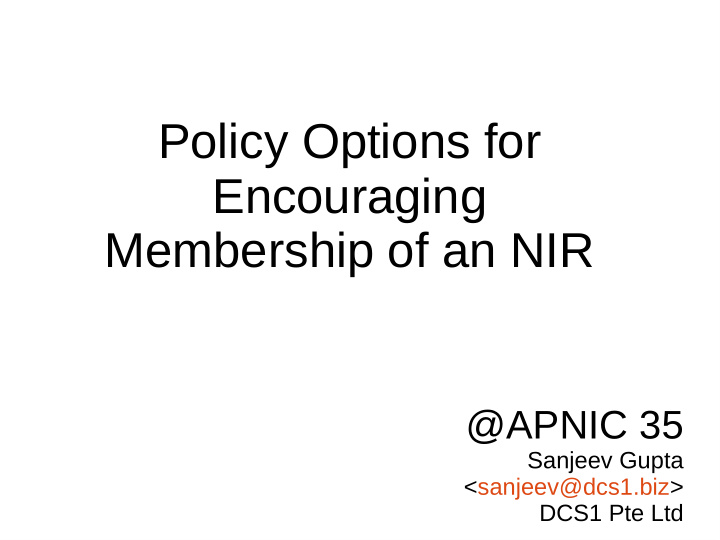



Policy Options for Encouraging Membership of an NIR @APNIC 35 Sanjeev Gupta <sanjeev@dcs1.biz> DCS1 Pte Ltd
The standard picture
We will see more NIRs in this RIR ● We now have seven ● There are other countries big enough to run an NIR ● APNIC is seen in some circles as being an outsider ● Governments may wish to have control of address space, the way they control telephone numbering space
Membership Competition ● RIRs do not compete with each other ● They do not need to, everyone knows APNIC is the biggest and best anyway :-) ● But newly-formed NIRs may be under pressure to show membership acceptance
Looking at a small part of the problem space ● Given that an NIR is formed, and measures success by the numbers of members it can attract from APNIC; – What policies could it pursue? ● Explicitly: “could”, not “should”. There are no Policy recommendations here.
Caveats ● This presentation has not had the benefit of extensive peer review ● It is in a very early stage ● Criticism is very much appreciated
Options 1.Follow APNIC policies, let LIRs choose 2.Differing policies, let LIRs choose 3.Offer lower resource pricing by splitting large allocations from APNIC 4.Regulatory Restrictions on LIRs being APNIC members
1. Follow APNIC policies, let LIRs choose ● APNIC's NIR Operational Policies require NIRs to “fully implement all applicable APNIC address management policies” ● An NIR can lower some transaction costs for local ISPs: – Exchange risk – Language barriers – Timezone issues ● Most of these are minor, and will likely attract new members only
2. Differing policies, let LIRs choose ● Assume that an NIR could implement policies significantly different from APNIC – Members would look at both, and choose the one that benefits them – This would have spill-over effects on other NIRs – It may even be feasible, then, for an ISP in one country to establish a unit in another to solicit resources from the “better” NIR ● To some extent, this does happen between RIRs
3. Lower resource pricing by splitting large allocations ● APNIC pricing: doubling your allocation increases costs by “only” 30% ● Assume: – ISP A, /17 , pays $7400 – ISP B, /17 , pays $7400 ● They apply as a joint company, for a /16 – They get a /16 , pay $9600 – Each ISP's share is only $4800 (save $2500, pays for an extra delegate to APNIC 35)
3. Lower resource pricing by splitting large allocations ● Why is this not common? – ISPs are natural competitors – Prestige of APNIC membership in one's name – For large ISPs, membership costs are monor anyway ● What if an NIR was to do this “aggregation”? – Neutral body – Small ISPs can particpate in the “volume discount” – Payments in local currency – Membership in NIR may be good enough branding
4. Regulatory Restrictions on LIRs being APNIC members ● APNIC NIR Member Relationship Agreement, 3.2(g): The NIR member must – To the extent permitted by the laws of the NIR Member's country or economy, guarantee the freedom of Local Internet Registries (LIRs), ISPs, and end users in their country or economy to choose between APNIC and the NIR Member as the registry from which they will receive Internet Resources
4. Regulatory Restrictions on LIRs being APNIC members ● An NIR could play the Good Cop/Bad Cop game – NIR supports choice of membership for ISPs – Govt denies ISP licences unless you are a member of the local NIR – NIR tells APNIC its hands are tied
(No) Conclusions ● Each NIR will have unique problems, and unique solutions ● “Happy families are all alike; every unhappy family is unhappy in its own way.” - Leo Tolstoy, Anna Karenina
Recommend
More recommend